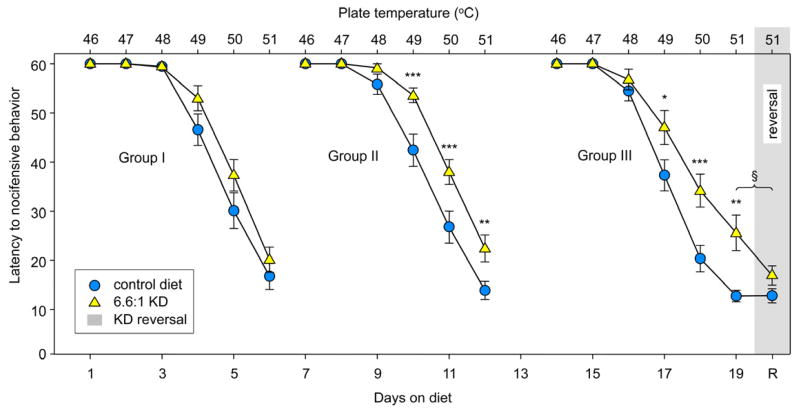Figure 1.
A 6.6:1 KD produces hypoalgesia which develops over time. Three groups of rats were challenged with an incremental 6-temperature test (one temperature per day) after varying times on the 6.6:1 KD. Top and bottom X-axes indicate hotplate temperature and days on diet, respectively. Gray shading indicates one day reversal of the KD in Group III. Left: Group I was tested from 1–6 days of KD feeding. Latency to behavioral response decreased with increased temperature, as expected, but there was no effect of the diet at any temperature at these early time points: Diet F=2.8, n.s.; Temperature F=160.3, p<0.001; Interaction F=1.5, n.s; n=20, both groups. Middle: Group II was tested across the same temperature range from 7–12 days, and a significant effect of diet was found; latency to behavioral response was increased in the KD group at 49, 50 and 51°C: Diet F=14.5, p<0.001; Temperature F=187.9, p<0.001; Interaction F=4.4, p<0.001; n=19–20. Right: Group III was tested from 14–19 days of KD feeding, and, similar to Group II, diet-induced hypoalgesia was also found at 49, 50 and 51°C: Diet F=5.7, p=0.19; Temperature F=158.4, p<0.001; Interaction F=4.0, p<0.001; n=18–20. Far right: After the last day of the temperature series, Group III KD-fed rats were reversed to the CD for 1 day (Day 20) and all rats were retested at 51°C. There was no difference between the behavioral response of this diet-reversal group and the CD-fed animals. *p<0.05, **p<0.01, ***p<0.001 compared to CD at corresponding temperatures. §p<0.05, t-test, comparing pre- and post-diet reversal values at 51°C in the 6.6:1 KD group.

